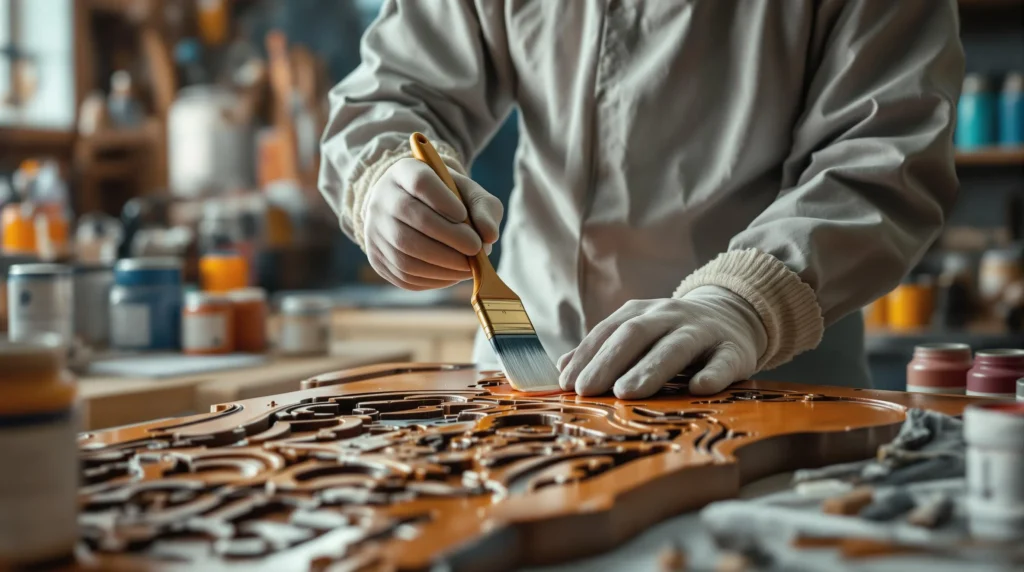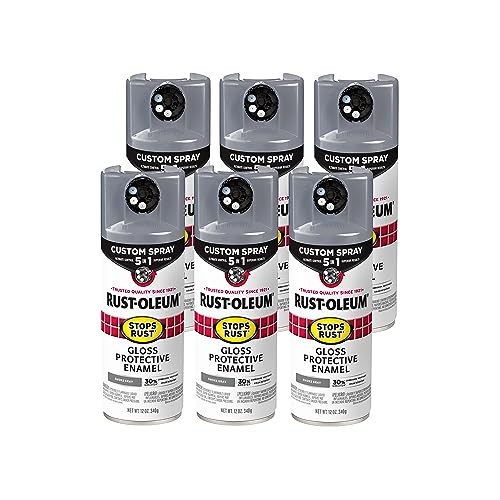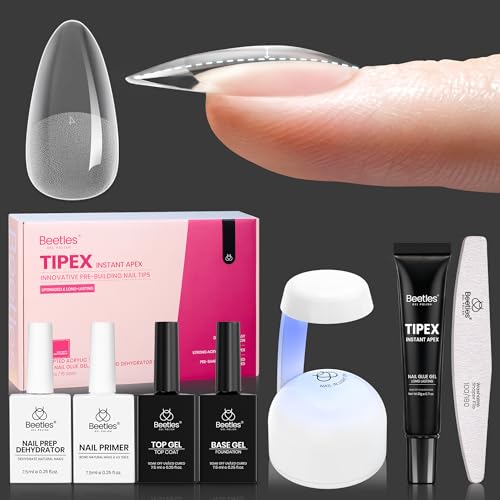Looking for a paint that delivers outstanding durability with a beautiful finish? Oil-based enamel paints remain the go-to choice for professionals and DIY enthusiasts who demand excellent results on high-traffic surfaces, furniture, and trim work.
We’ve tested dozens of brands to identify which oil-based enamel paints truly deliver on their promises. Our comprehensive research focuses on factors like coverage, finish quality, drying time, and long-term performance. Whether you’re tackling an interior renovation or refreshing outdoor elements, choosing the right enamel paint can make all the difference in your project’s success and longevity.
Understanding Oil-Based Enamel Paint: Benefits and Applications
Oil-based enamel paint has remained a staple in the painting industry for decades due to its exceptional qualities. These paints create a hard, durable finish that withstands daily wear and tear better than many alternatives. Professional painters often choose oil-based enamels for surfaces that need superior protection against moisture, chemicals, and physical impact.
One of the most important advantages of oil-based enamel is its outstanding durability. This type of paint forms a tough shell once cured, making it ideal for high-traffic areas such as doors, trim, and cabinets. The robust finish resists chipping and scratching, maintaining its appearance even in challenging environments like kitchens and bathrooms.
Another benefit worth noting is the smooth, lustrous finish that oil-based enamels provide. These paints self-level during application, reducing brush marks and creating a flawless surface. Many homeowners prefer this glossy, professional-looking result that adds an elegant touch to woodwork and metal surfaces.
Oil-based enamels excel in adhesion properties, forming a strong bond with properly prepared surfaces. They adhere well to previous paint layers and can even stick to slightly oily or dirty surfaces better than water-based alternatives. This characteristic makes them particularly useful for repainting old furniture or metal items without extensive preparation.
The versatility of oil-based enamel paints extends to various applications throughout the home. These paints perform exceptionally well on trim work, doors, cabinets, furniture, and metal surfaces. Exterior applications include railings, garden furniture, and decorative metal elements that require protection from the elements.
Weather resistance stands as another key advantage of oil-based enamels. These paints create a water-resistant barrier that protects surfaces from rain, snow, and humidity. For outdoor projects exposed to harsh conditions, oil-based options typically outlast water-based alternatives by years rather than months.
Colors in oil-based enamels tend to remain vibrant longer than in other paint formulations. The pigments are suspended in the oil medium, creating rich, saturated tones that resist fading even with regular exposure to sunlight. This color retention makes them particularly valuable for exterior applications or interior spaces with abundant natural light.
Even though their many benefits, oil-based enamels do come with some drawbacks. These paints typically release strong odors during application and drying, requiring proper ventilation. Cleanup involves solvents like mineral spirits rather than soap and water, adding an extra step to the painting process. Also, drying times range from 6-24 hours between coats, significantly longer than water-based alternatives.
For optimal results with oil-based enamel paints, proper surface preparation remains essential. Cleaning, sanding, and priming create the foundation for a successful paint job. Many professionals recommend dedicated oil-based primers for maximum adhesion and durability, especially on bare wood or metal surfaces.
Top 10 Best Oil-Based Enamel Paints for Professional Results
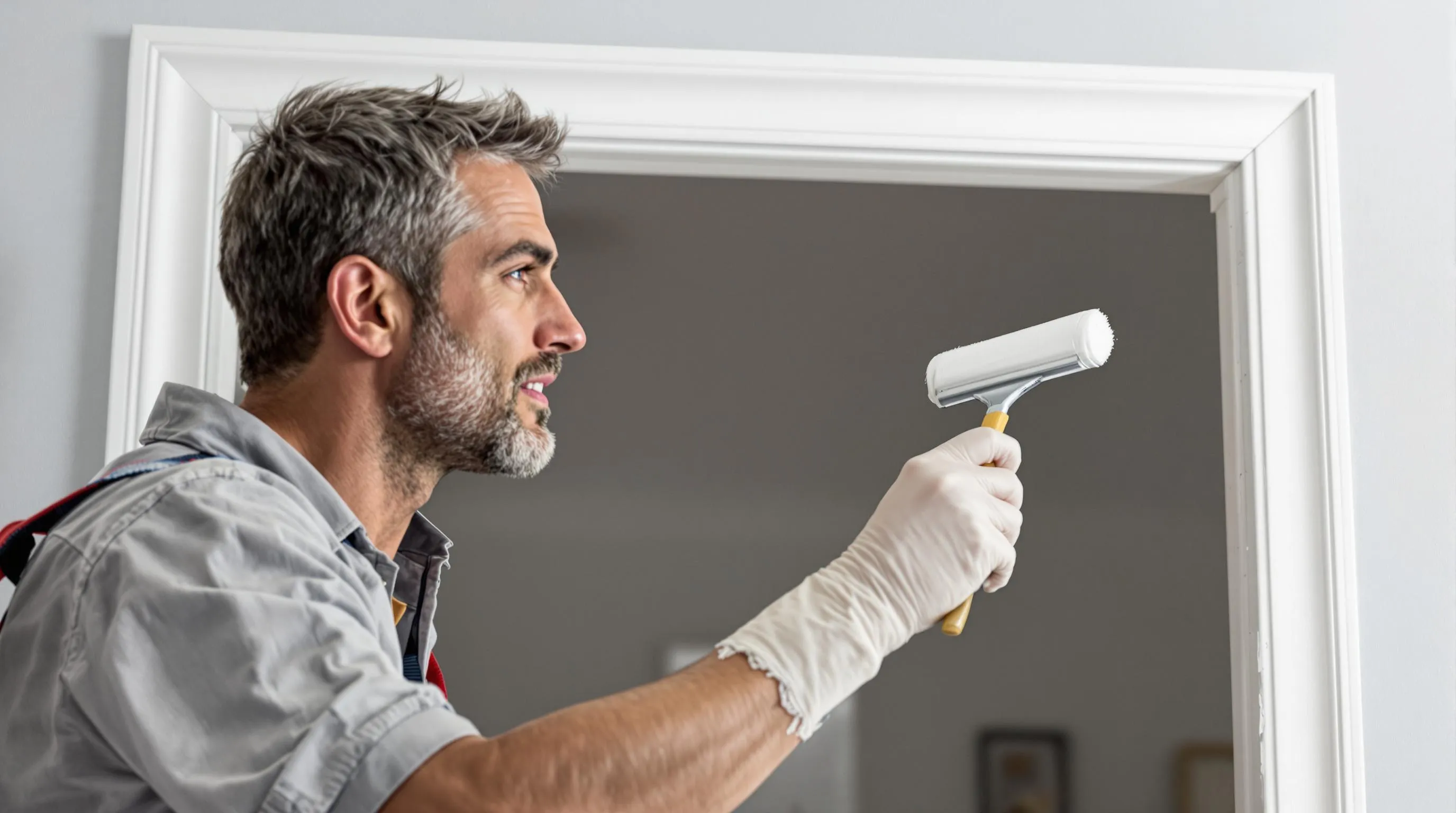
After extensive testing across various surfaces and conditions, we’ve identified the top oil-based enamel paints that deliver exceptional performance and professional results. These products stand out for their durability, finish quality, and overall value.
Rust-Oleum Oil-Based Protective Enamel
Rust-Oleum’s Oil-Based Protective Enamel tops our list for its outstanding coverage and remarkable durability. This versatile paint performs exceptionally well on both metal and wood surfaces, making it perfect for restoration projects and new applications alike. Users consistently praise its smooth application and resistance to chipping, even in high-traffic areas. The paint’s weather-resistant formula creates a protective barrier that helps prevent rust and corrosion, extending the lifespan of outdoor projects.
Benjamin Moore Impervo High-Gloss Enamel
Benjamin Moore Impervo High-Gloss Enamel delivers a stunning mirror-like finish that transforms ordinary surfaces into showpieces. Professional painters favor this premium enamel for its self-leveling properties that eliminate brush marks and create a flawless appearance. The paint’s rich formulation provides excellent coverage while maintaining color depth and clarity over time. Impervo’s durability stands out particularly on trim work and cabinetry, where its hardness resists daily wear and cleaning.
Sherwin-Williams ProClassic Alkyd Interior Enamel
Sherwin-Williams ProClassic Alkyd Interior Enamel offers an unmatched smooth finish that’s ideal for interior woodwork and trim. Professionals appreciate its excellent flow and leveling capabilities that minimize brush marks even on detailed surfaces. The paint’s durable formula withstands repeated cleaning without losing its sheen or color intensity. ProClassic’s adhesion properties create a strong bond with properly prepared surfaces, reducing the likelihood of peeling or chipping over time.
Duron Industrial Enamel
Duron Industrial Enamel excels in heavy-duty applications where standard paints would quickly deteriorate. This professional-grade formula stands up to harsh conditions, making it perfect for commercial and industrial settings. The paint’s exceptional stain resistance allows for easy cleanup of spills and marks without damaging the finish. Duron’s resilient coating maintains its appearance even though exposure to chemicals, moisture, and abrasion that would quickly deteriorate lesser products.
Behr Oil-Based Enamel
Behr Oil-Based Enamel combines affordability with impressive performance for both interior and exterior applications. DIY enthusiasts praise its user-friendly application that flows smoothly even for those with limited painting experience. The paint’s superior color retention prevents fading, keeping surfaces looking fresh for years after application. Behr’s formulation provides excellent coverage, often requiring fewer coats than competing brands while maintaining consistent color and finish.
Valspar Oil-Based Door & Trim Enamel
Valspar Oil-Based Door & Trim Enamel specializes in creating perfect finishes on architectural details throughout the home. The product’s balanced viscosity allows for precise application on intricate trim work and detailed door panels. This enamel creates a hard, durable surface that resists scuffs and scratches in high-contact areas like doorframes and baseboards. Valspar’s formula achieves a professional-looking finish that enhances the character of woodwork while providing lasting protection.
KILZ Complete Coat Oil-Based Enamel
KILZ Complete Coat Oil-Based Enamel offers exceptional versatility with its all-in-one formulation suitable for diverse surfaces. The paint’s high-coverage formula often eliminates the need for multiple coats, saving both time and material costs. Professional painters appreciate its consistent performance across different project types, from furniture refinishing to accent walls. KILZ’s durability ensures the finish maintains its appearance even though regular use and cleaning.
PPG Breakthrough Oil-Based Enamel
PPG Breakthrough Oil-Based Enamel showcases remarkable hardness and chemical resistance that professionals demand for challenging environments. The paint cures to an exceptionally tough finish that withstands impacts that would damage standard enamels. Laboratory testing confirms its resistance to harsh cleaning chemicals, making it ideal for commercial kitchens and bathrooms. PPG’s advanced formulation provides these performance benefits while maintaining an attractive appearance that enhances the project’s visual appeal.
Dutch Boy Oil-Based Porch & Floor Enamel
Dutch Boy Oil-Based Porch & Floor Enamel creates beautiful, lasting finishes on exterior floor surfaces exposed to the elements. The specialized formula resists foot traffic, furniture movement, and weather exposure without showing premature wear. This paint’s water-resistant properties prevent moisture penetration that can lead to wood rot and concrete deterioration. Dutch Boy’s balanced drying time allows for proper curing even in variable outdoor conditions, ensuring maximum durability and performance.
Majic Paints Diamond Hard Oil-Based Enamel
Majic Paints Diamond Hard Oil-Based Enamel lives up to its name with exceptional hardness that withstands daily abuse. The paint’s versatile formulation adheres well to multiple surfaces including wood, metal, and properly prepared plastics. DIY enthusiasts appreciate its forgiving application that allows for touch-ups and corrections without obvious transitions. Majic’s cost-effective pricing makes it accessible for large projects without compromising on quality or durability that professional results demand.
Key Factors to Consider When Choosing Oil-Based Enamel Paint
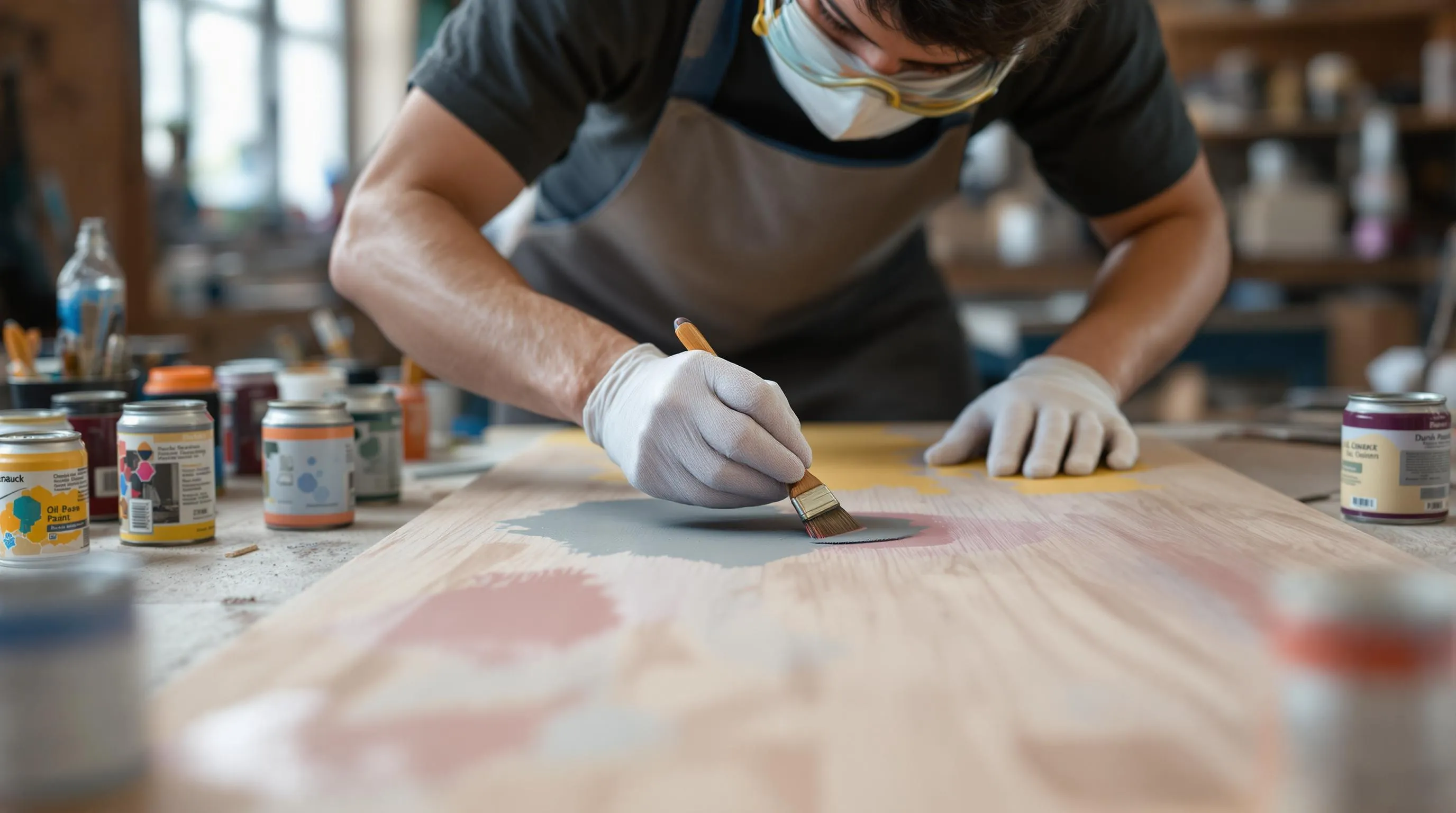
Durability and Hardness
Durability should be your primary consideration when selecting an oil-based enamel paint. These paints create exceptionally hard protective layers that resist wear, chipping, and scratching even in high-traffic areas. Products like Rust-Oleum Stops Rust Protective Enamel offer superior durability with excellent weather resistance, making them perfect for both indoor and outdoor applications. The hardness of oil-based enamels develops gradually during the curing process, creating a surface that stands up to daily abuse far better than most alternative coating types.
Drying and Curing Time
Drying time varies significantly between different oil-based enamel brands and formulations. Most oil-based enamels require longer drying periods compared to water-based alternatives, with some products needing 24 hours between coats. Benjamin Moore Advance Interior Paint, while highly durable, demands a longer recommended time between coats for full curing and optimal results. Quick-drying options like Behr Alkyd Semi-Gloss Enamel can be advantageous for time-sensitive projects, though they may not provide the same depth of finish as slower-drying formulas. Remember that ambient temperature and humidity significantly impact drying times.
VOC Content and Odor
VOC (Volatile Organic Compound) levels directly affect both safety and comfort during application. Traditional oil-based enamels typically contain higher VOC content, resulting in stronger odors and potentially more environmental and health concerns. Products like Benjamin Moore Advance Interior Paint feature lower VOC formulations that reduce odor while maintaining performance. Standard alkyd paints such as Behr Alkyd Semi-Gloss Enamel contain more VOCs but deliver excellent durability. Proper ventilation remains essential when working with any oil-based product regardless of VOC content.
Finish Options
Finish selection dramatically impacts both appearance and functionality of your painted surface. Oil-based enamels typically come in high-gloss, semi-gloss, satin, and matte options, each serving different aesthetic and practical purposes. High-gloss finishes reflect more light and prove easier to clean, making them ideal for trim work and cabinets. Semi-gloss options like Behr Alkyd Semi-Gloss Enamel enhance wood surfaces with a balance of sheen and practicality. Satin and matte finishes reduce light reflection, helping hide surface imperfections while creating a more subdued look.
Surface Compatibility
Surface compatibility determines ultimate adhesion and longevity of your paint job. Different oil-based enamels perform better on exact materials, with products formulated for particular applications. Rust-Oleum Stops Rust Protective Enamel works excellently on both indoor and outdoor wood surfaces with proper preparation. Benjamin Moore Advance Interior Paint excels specifically on wood surfaces like cabinets, doors, and furniture. Paints designed for metal surfaces contain special rust-inhibiting compounds that protect the underlying material. Always verify that your chosen paint matches your intended surface to ensure optimal adhesion and performance over time.
Best Oil-Based Enamel Paints for Specific Projects
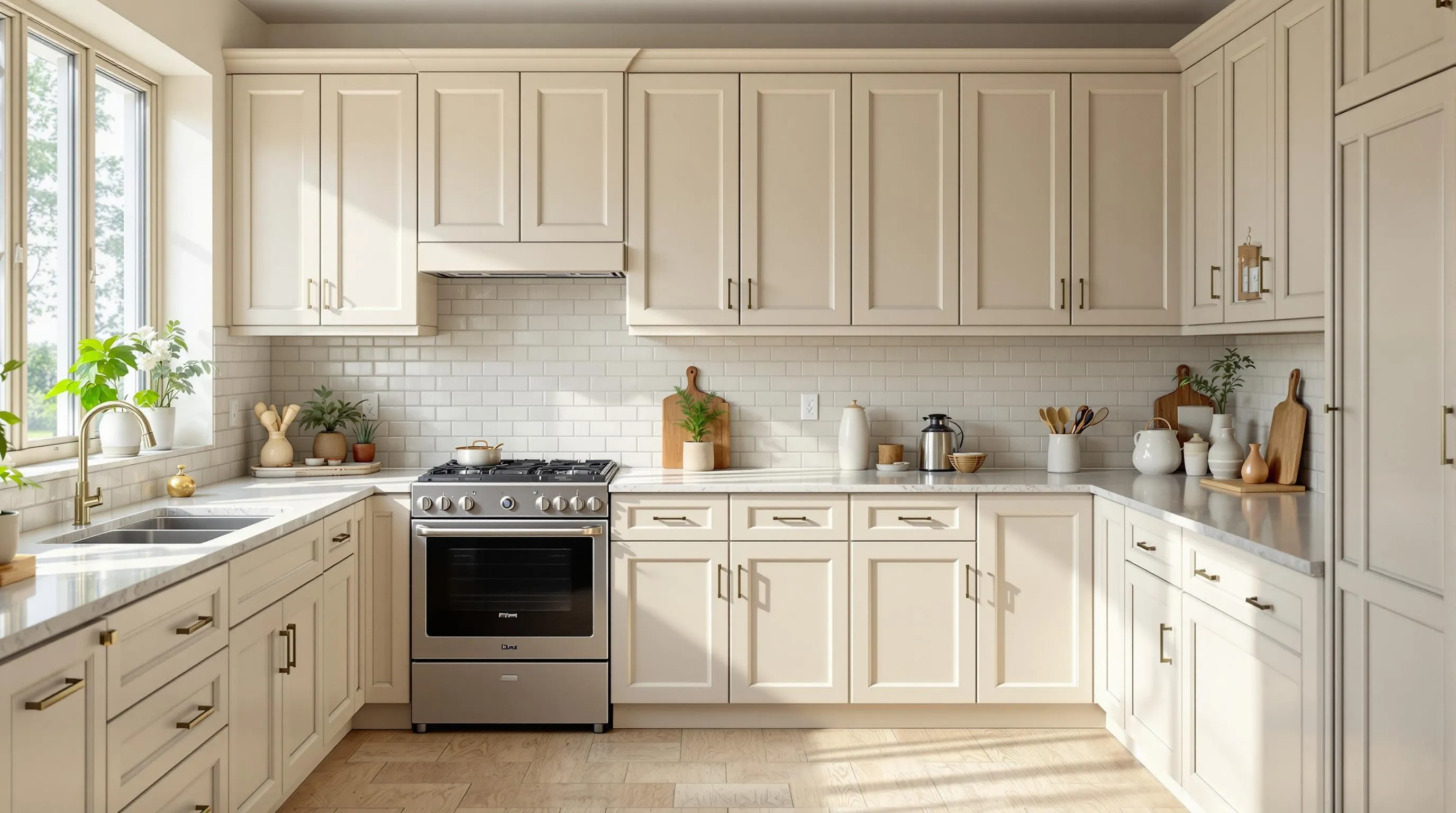
Different projects demand exact paint formulations to achieve optimal results. We’ve compiled the best oil-based enamel options customized for various applications based on extensive testing and professional recommendations.
For Furniture Restoration
Benjamin Moore Advance Interior Paint stands out as an exceptional choice for breathing new life into old furniture pieces. This low VOC hybrid formula offers oil-based durability with the convenience of water-based cleanup, making it perfect for achieving smooth finishes on cabinets and cherished furniture items. Its self-leveling properties ensure a flawless appearance without brush marks.
Behr Alkyd Semi-Gloss Enamel provides a budget-friendly alternative without compromising quality. The quick-drying formula allows for faster project completion while delivering a beautiful semi-gloss finish that enhances wood furniture. Many DIY enthusiasts appreciate its balance of affordability and performance when tackling furniture restoration projects.
For Metal Surfaces
Rust-Oleum Stops Rust Protective Enamel delivers superior adhesion and exceptional weather resistance for both indoor and outdoor metal applications. This formula creates a tough barrier against corrosion, making it ideal for metal railings, gates, and decorative elements that need long-lasting protection. The paint flows smoothly and levels well on metal surfaces.
PPG Advantage 9000 excels at bonding over existing oil-based coatings without the need for extensive surface preparation. This paint provides strong durability for metal trims and fixtures, offering professional-grade results. Its robust finish stands up to regular handling and cleaning, making it suitable for frequently touched metal surfaces throughout the home.
For Kitchen and Bathroom Cabinets
Benjamin Moore Advance performs impressively in high-moisture environments like kitchens and bathrooms. The low odor formula and smooth application process make cabinet painting projects more manageable, while its resistance to yellowing ensures your cabinets maintain their beauty for years. Cabinet doors and drawers benefit from its hard, furniture-quality finish.
Sherwin-Williams Emerald Urethane delivers extraordinary durability thanks to its urethane enhancement. This formulation maintains excellent gloss retention even with repeated cleaning, making it specifically valuable for cabinetry in busy households. The paint cures to a hard, smooth finish that resists stains and moisture damage common in kitchen and bathroom spaces.
For Outdoor Applications
Rust-Oleum Stops Rust provides comprehensive protection for outdoor wood and metal elements against the elements. This formula guards against rust, chipping, and harmful UV damage that can deteriorate exterior surfaces over time. Garden furniture, railings, and decorative metal features maintain their appearance longer when protected with this specialized coating.
PPG Advantage 9000 offers a weather-resistant finish that stands up to challenging outdoor conditions. Exterior trim and surfaces coated with this paint maintain their integrity through seasonal changes and exposure to moisture. The durable finish resists cracking and peeling, making it an excellent investment for protecting outdoor structures that face constant environmental challenges.
Professional Tips for Applying Oil-Based Enamel Paint

After choosing the right oil-based enamel paint for your project, proper application techniques are crucial for achieving that professional-quality finish. We’ve compiled expert advice to help you master the application process from start to finish.
Surface Preparation Techniques
Proper surface preparation forms the foundation of any successful painting project. Start by thoroughly cleaning the surface with trisodium phosphate (TSP) to remove all dirt, grease, and contaminants that could prevent proper adhesion. Sand the surface carefully to smooth out any imperfections, creating an even base for your paint application. Always apply an oil-based primer specifically formulated for your surface type to enhance adhesion and provide a uniform base for the topcoat. This critical step not only improves the final appearance but significantly extends the lifespan of your paint job by creating the optimal foundation for the enamel to bond with the surface.
Application Methods for Smooth Results
Achieving a flawless finish requires both quality tools and proper technique. Use high-quality synthetic bristle brushes or foam rollers specifically designed for oil-based paints to minimize brush marks and ensure even coverage. Maintain a wet edge while painting to prevent visible lap marks that can ruin the smooth appearance of your finish. Apply thin, even coats rather than one thick layer to avoid drips and sags that are difficult to correct once dried. Between coats, lightly sand the surface with 220-grit sandpaper to remove any imperfections and create a smooth base for the next application. Allow each coat to dry completely for 16-24 hours before applying subsequent layers to prevent peeling and ensure proper curing.
Clean-Up and Brush Care
Proper tool maintenance extends the life of your painting equipment and ensures better results on future projects. Clean brushes and rollers immediately after use with mineral spirits or paint thinner to prevent the enamel from hardening in the bristles. During short breaks, wrap your brushes in plastic wrap or aluminum foil to keep them from drying out and becoming unusable. For long-term storage, clean brushes thoroughly and hang them bristle-down to maintain their shape and functionality. Always follow local regulations when disposing of oil-based paint products and cleaning materials, as they’re typically classified as hazardous waste. Remember to work in well-ventilated areas due to the high VOC content of oil-based enamels, and allow painted surfaces to fully cure for up to 30 days before subjecting them to heavy use or cleaning.
Common Mistakes to Avoid When Using Oil-Based Enamel Paint
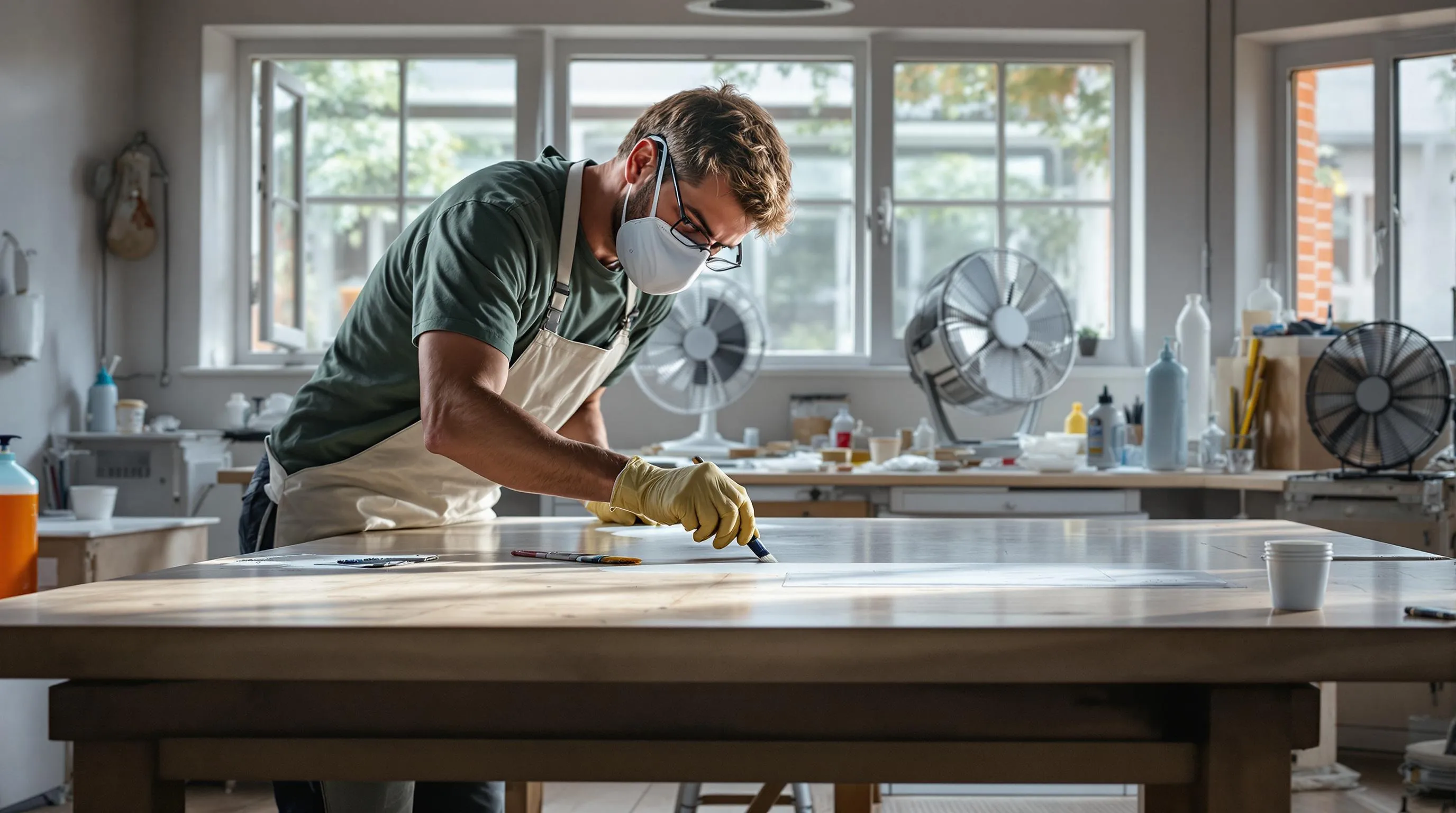
Even with the premium quality of oil-based enamel paints like Rust-Oleum and Benjamin Moore, achieving professional results requires avoiding these common pitfalls:
Insufficient Surface Preparation
Surface preparation makes or breaks your painting project. Many DIYers rush this crucial step, resulting in poor adhesion and an uneven finish. Always sand surfaces thoroughly before applying oil-based enamel paint to create a proper bonding surface. We’ve found that cleaning with trisodium phosphate removes grease and grime that would otherwise prevent the paint from adhering correctly.
Inadequate Ventilation
Oil-based enamels emit strong fumes that can cause health issues when inhaled for extended periods. Always work in well-ventilated spaces by opening windows and using fans to circulate air. Safety should never be compromised, especially when working with high-VOC formulations like traditional oil-based paints. Many professionals use respirators with organic vapor cartridges during indoor applications.
Using Incorrect Thinners
Thinning oil-based enamel with the wrong solvent can dramatically affect paint performance. Only use manufacturer-recommended thinners such as mineral spirits or paint thinner specifically designed for oil-based products. Water will never mix properly with oil-based paint and will ruin your entire batch. Reading product labels before purchasing thinners ensures compatibility with your exact brand of enamel paint.
Ignoring Drying Times
Patience truly pays off when working with oil-based enamels. Their longer drying time compared to water-based alternatives requires careful planning. Applying a second coat before the first one fully cures often results in wrinkling, uneven texture, or peeling paint down the road. Manufacturer specifications typically recommend 24-48 hours between coats, depending on humidity and temperature conditions.
Not Using Protective Gear
Proper protection while working with oil-based paints prevents skin irritation and respiratory issues. Gloves protect your hands from harsh solvents that can cause dermatitis with repeated exposure. Quality masks or respirators filter out harmful volatile organic compounds that oil-based paints release during application and drying. Eye protection guards against accidental splashes that could cause serious irritation.
How to Properly Maintain Oil-Based Enamel Painted Surfaces
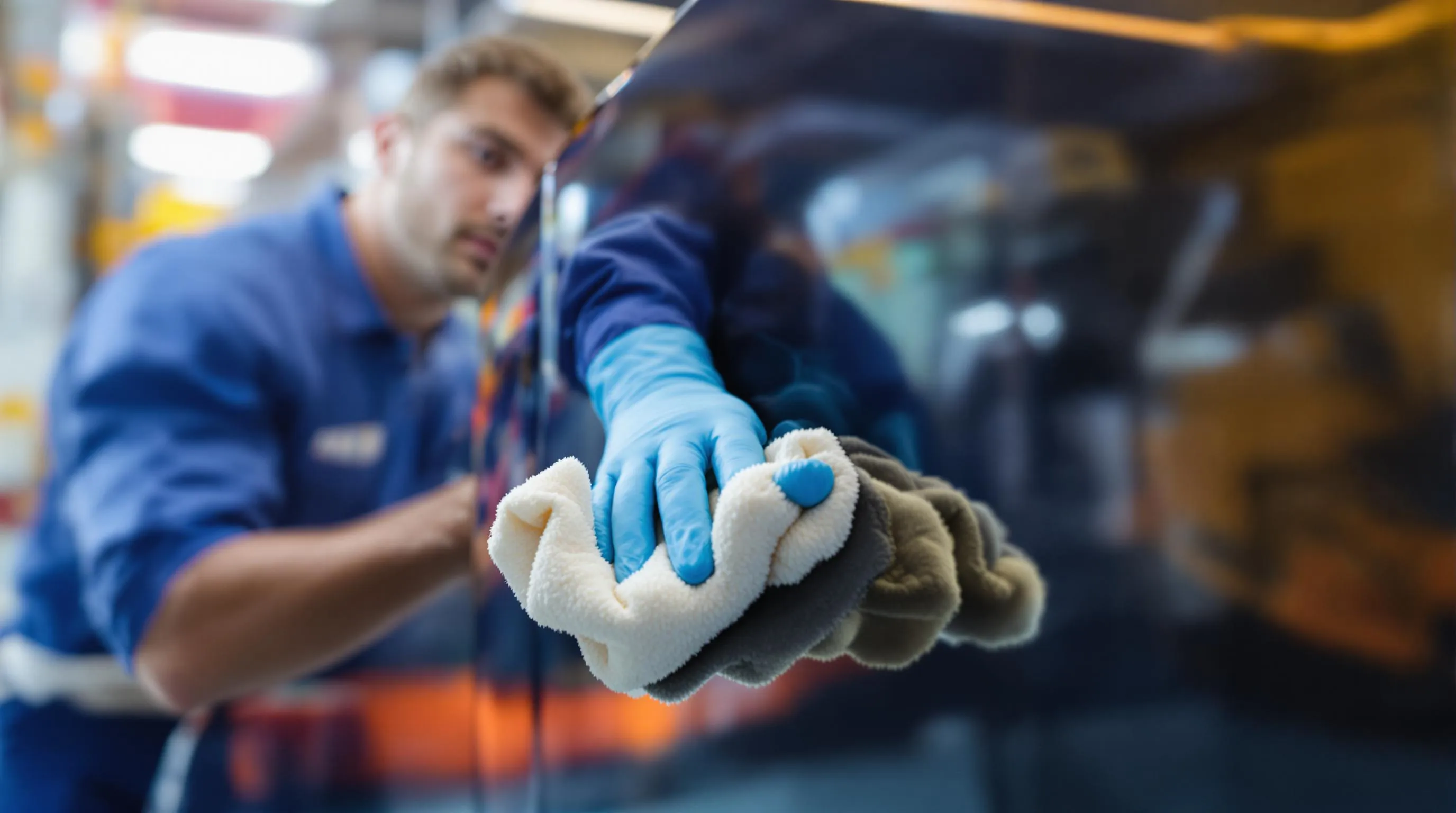
Regular Cleaning Techniques
Oil-based enamel surfaces require gentle cleaning to maintain their lustrous finish. We recommend using mild soap and water for routine cleaning of your painted surfaces. Harsh or abrasive cleaners should be avoided as they can damage the glossy finish that makes oil-based enamel so attractive. Soft microfiber cloths work best for wiping down surfaces without scratching. Monthly cleaning helps prevent dirt buildup that can eventually become more difficult to remove without damaging the paint.
Addressing Scratches and Damage
Prompt attention to scratches and chips is essential for preserving the integrity of oil-based enamel surfaces. Small imperfections should be addressed quickly using matching paint to prevent moisture from penetrating beneath the surface. For deeper scratches, light sanding with fine-grit sandpaper followed by spot painting yields the best results. Touch-up kits are available from most manufacturers, making it easier to match your existing finish perfectly.
Protecting Against UV Damage
Outdoor surfaces painted with oil-based enamel require additional protection against the sun’s harmful rays. Applying a clear topcoat or UV-resistant sealant helps minimize fading and extends the life of your painted surfaces. Annual inspection of outdoor items allows you to catch UV damage early before it becomes severe. Quality UV protectants specifically designed for oil-based paints provide the most effective defense against color degradation and surface deterioration.
Recoating Considerations
Proper timing is crucial when recoating oil-based enamel surfaces. Full curing must occur before applying additional coats, which typically takes 7-30 days for oil-based paints. Rushing this process often leads to adhesion problems and an uneven finish. Surface preparation remains important even for recoating, requiring light sanding to create a bond between the existing paint and new layer. Ventilation during recoating helps reduce strong odors and accelerates the drying process.
Seasonal Maintenance Tips
Seasonal changes affect oil-based enamel differently than water-based alternatives. Winter months might cause slight contraction in the paint film, while summer heat and humidity can affect outdoor applications. Regular inspections during season transitions help identify potential issues before they worsen. Oil-based enamel’s superior moisture resistance makes it particularly valuable in humid environments, but this advantage requires proper maintenance to preserve. Protective covers for outdoor furniture during extreme weather conditions extend the life of your painted surfaces significantly.
Conclusion: Choosing the Right Oil-Based Enamel Paint for Your Needs
Selecting the perfect oil-based enamel paint doesn’t have to be overwhelming. We’ve explored top-performing brands that deliver exceptional durability, adhesion and finish quality for various applications.
Remember that successful projects require more than just premium paint – proper surface preparation, application techniques and maintenance are equally crucial. While oil-based enamels require more patience during drying and careful handling, their superior finish and longevity make them worth the extra effort.
Whether you’re restoring furniture, refreshing kitchen cabinets or protecting outdoor metal surfaces, there’s an oil-based enamel paint that’ll meet your exact needs. By considering our recommendations and following professional application tips, you’ll achieve stunning, long-lasting results that stand the test of time.
Frequently Asked Questions
What makes oil-based enamel paint different from other paints?
Oil-based enamel paints create a harder, more durable finish compared to water-based alternatives. They have self-leveling properties that result in a smooth, lustrous finish, making them ideal for woodwork and metal surfaces. These paints also excel in adhesion, even on slightly oily or dirty surfaces, and offer superior weather resistance for outdoor applications. Their pigments suspended in oil maintain vibrant colors longer than other paint types.
How long does oil-based enamel paint take to dry?
Oil-based enamel paints typically take longer to dry than water-based alternatives. Most require 6-8 hours to become touch-dry and 24 hours before applying a second coat. Full curing, where the paint reaches maximum hardness and durability, can take 7-30 days depending on the brand, humidity, and temperature. Always check manufacturer specifications for exact drying times.
What surfaces work best with oil-based enamel paint?
Oil-based enamel paints perform exceptionally well on wood trim, cabinets, doors, furniture, and metal surfaces. They’re particularly suited for high-traffic areas and surfaces that need frequent cleaning due to their durability and resistance to chipping. These paints also excel on outdoor metal furniture, railings, and decorative elements because of their superior weather resistance and long-lasting finish.
Do I need to prime before applying oil-based enamel paint?
Yes, priming is essential for optimal results with oil-based enamel paints. A dedicated oil-based primer enhances adhesion, prevents bleed-through, and creates a uniform base for the topcoat. Proper priming helps extend the life of your paint job and improves the final appearance. On previously painted surfaces in good condition, light sanding may be sufficient instead of priming.
How do I clean up after using oil-based enamel paint?
Clean brushes, rollers, and tools with mineral spirits or paint thinner immediately after use. Never use water, as it won’t remove oil-based paint. Work in a well-ventilated area during cleanup, and dispose of solvents properly according to local regulations. For hands, use a painter’s soap or specialized hand cleaner designed for oil-based products, followed by regular soap and warm water.
What are the best brands of oil-based enamel paint?
Top-rated oil-based enamel paints include Rust-Oleum Oil-Based Protective Enamel, Benjamin Moore Impervo High-Gloss Enamel, and Sherwin-Williams ProClassic Alkyd Interior Enamel. Other excellent options are Dulux Oil-Based Gloss Enamel, Behr Alkyd Semi-Gloss Enamel, and Fine Paints of Europe Hollandlac Brilliant. These brands consistently deliver superior coverage, finish quality, and durability across various applications.
How can I maintain surfaces painted with oil-based enamel?
Clean painted surfaces gently with mild soap and water using a soft cloth or sponge. Avoid harsh chemical cleaners that can damage the finish. Address scratches or damage promptly with light sanding and touch-up paint. For outdoor applications, apply a clear protective topcoat every few years to guard against UV damage. Allow full curing before regular cleaning or placing heavy items on painted surfaces.
Are oil-based enamel paints safe to use indoors?
Oil-based enamels contain higher VOC levels than water-based alternatives, making proper ventilation essential. Always work in well-ventilated spaces with open windows, fans, or exhaust systems. Wear appropriate protective gear including respirators rated for organic vapors. Consider temporarily relocating during large indoor projects, especially for those with respiratory conditions, children, and pregnant women. Always follow manufacturer safety guidelines.
What’s the best application method for oil-based enamel paint?
For the smoothest finish, use high-quality natural bristle brushes or foam rollers specifically designed for oil-based paints. Apply thin, even coats rather than one thick coat to prevent drips and sags. Work in sections, maintaining a wet edge to avoid lap marks. For large, flat surfaces, consider using a paint sprayer with appropriate thinning according to manufacturer recommendations. Always strain paint before use to remove particles.
How environmentally friendly are oil-based enamel paints?
Oil-based enamels generally have higher VOC content than water-based alternatives, making them less environmentally friendly. However, many manufacturers now offer low-VOC or “green” oil-based formulations that reduce environmental impact while maintaining performance benefits. These eco-friendlier options typically have less odor and fewer harmful emissions. Always dispose of leftover paint and solvents according to local hazardous waste guidelines to minimize environmental harm.

